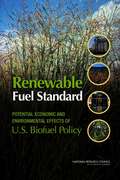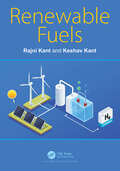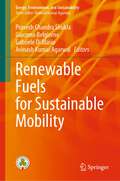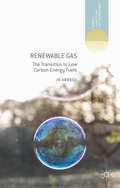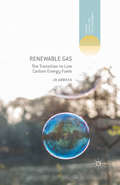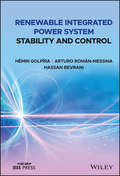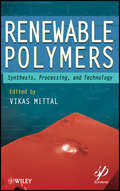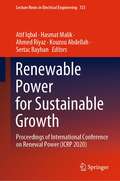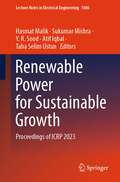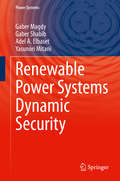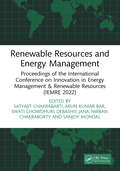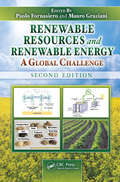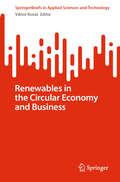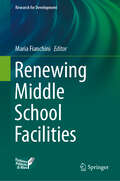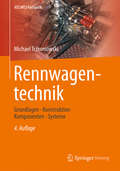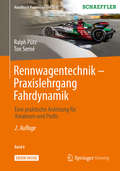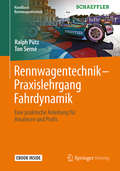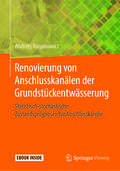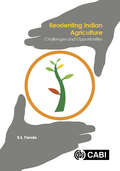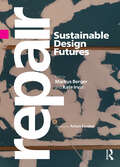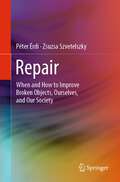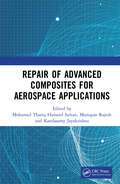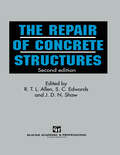- Table View
- List View
Renewable Fuel Standard: Potential Economic and Environmental Effects of U.S. Biofuel Policy
by Committee on Economic Environmental Impacts of Increasing Biofuels ProductionIn the United States, we have come to depend on plentiful and inexpensive energy to support our economy and lifestyles. In recent years, many questions have been raised regarding the sustainability of our current pattern of high consumption of nonrenewable energy and its environmental consequences. Further, because the United States imports about 55 percent of the nation's consumption of crude oil, there are additional concerns about the security of supply. Hence, efforts are being made to find alternatives to our current pathway, including greater energy efficiency and use of energy sources that could lower greenhouse gas (GHG) emissions such as nuclear and renewable sources, including solar, wind, geothermal, and biofuels. The United States has a long history with biofuels and the nation is on a course charted to achieve a substantial increase in biofuels. Renewable Fuel Standard evaluates the economic and environmental consequences of increasing biofuels production as a result of Renewable Fuels Standard, as amended by EISA (RFS2). The report describes biofuels produced in 2010 and those projected to be produced and consumed by 2022, reviews model projections and other estimates of the relative impact on the prices of land, and discusses the potential environmental harm and benefits of biofuels production and the barriers to achieving the RFS2 consumption mandate. Policy makers, investors, leaders in the transportation sector, and others with concerns for the environment, economy, and energy security can rely on the recommendations provided in this report.
Renewable Fuels
by Rajni Kant Keshav KantRenewable fuels, in the present times, have become important to curb emission of greenhouse gases, which are causing damage to the environment and leading to climatic changes. Ideally, their utilization can be a zero carbon operation. Planting suitable trees on all waste lands and agro forestry on a large scale can fulfil the needs of timber, fuel, fruits, etc. All kinds of lignocellulosic biomass can be converted by several methods to useful liquid fuels like alcohols, biodiesel, methane, renewable diesel and renewable gasoline. Hydrogen can be used as a renewable fuel because of its desirable characteristics and properties for its use as a green fuel.
Renewable Fuels for Sustainable Mobility (Energy, Environment, and Sustainability)
by Pravesh Chandra Shukla Giacomo Belgiorno Gabriele Di Blasio Avinash Kumar AgarwalThis volume discusses the use of renewable fuels for clean transportation and its applications on internal combustion engines. The contents focus on the key aspects of fuel production processes and its impact on various segments of the transportation sector and for sustainable mobility. Several kinds of fuels are assessed such as biofuels, alcohols, and hydrogen, and their effects on the combustion process are characterized by application. This volume will be of use to those working in academia and industry as well as energy experts and policy makers.
Renewable Gas: The Transition to Low Carbon Energy Fuels (Energy, Climate and the Environment)
by Jo AbbessThe author looks at the prospects for a transition from natural gas to low carbon gas, which could take several decades, and at how this will depend on the evolution of the fossil fuel industry. She investigates the technologies and energy systems for making the best use of renewable gas resources.
Renewable Gas: The Transition to Low Carbon Energy Fuels (Energy, Climate and the Environment)
by Jo AbbessThe author looks at the prospects for a transition from natural gas to low carbon gas, which could take several decades, and at how this will depend on the evolution of the fossil fuel industry. She investigates the technologies and energy systems for making the best use of renewable gas resources.
Renewable Integrated Power System Stability and Control (Wiley - IEEE)
by Hêmin Golpîra Arturo Román-Messina Hassan BevraniDiscover new challenges and hot topics in the field of penetrated power grids in this brand-new interdisciplinary resource Renewable Integrated Power System Stability and Control delivers a comprehensive exploration of penetrated grid dynamic analysis and new trends in power system modeling and dynamic equivalencing. The book summarizes long-term academic research outcomes and contributions and exploits the authors’ extensive practical experiences in power system dynamics and stability to offer readers an insightful analysis of modern power grid infrastructure. In addition to the basic principles of penetrated power system modeling, model reduction, and model derivation, the book discusses inertia challenge requirements and control levels, as well as recent advances in visualization of virtual synchronous generators and their associated effects on system performance. The physical constraints and engineering considerations of advanced control schemes are deliberated at length. Renewable Integrated Power System Stability and Control also considers robust and adaptive control strategies using real-time simulations and experimental studies. Readers will benefit from the inclusion of: A thorough introduction to power systems, including time horizon studies, structure, power generation options, energy storage systems, and microgrids An exploration of renewable integrated power grid modeling, including basic principles, host grid modeling, and grid-connected MG equivalent models A study of virtual inertia, including grid stability enhancement, simulations, and experimental results A discussion of renewable integrated power grid stability and control, including small signal stability assessment and the frequency point of view Perfect for engineers and operators in power grids, as well as academics studying the technology, Renewable Integrated Power System Stability and Control will also earn a place in the libraries of students in Electrical Engineering programs at the undergraduate and postgraduate levels who wish to improve their understanding of power system operation and control.
Renewable Polymers: Synthesis, Processing, and Technology
by Vikas MittalPresents the synthesis, technology and processing details of a large range of polymers derived from renewable resources It has been a long-term desire to replace polymers from fossil fuels with the more environmentally friendly polymers generated from renewable resources. Now, with the recent advancements in synthesis technologies and the finding of new functional monomers, research in this field has shown strong potential in generating better property polymers from renewable resources. A text describing these advances in synthesis, processing, and technology of such polymers not only provides the state-of-the-art information to researchers, but also acts to stimulate research in this direction. The contents are based on a wide range of functional monomers and the contributions are written by eminent researchers. Specifically Renewable Polymers: Demonstrates the design, synthesis, properties and applications of plant oil-based polymers Presents an elaborate review of acid mediated polymerization techniques for the generation of green polymers Details the production of polyhydroxyalkanoates (PHA) from olive oil based wastewater Describes the use of atom transfer radical polymerization (ATRP) techniques Reviews the renewable polymers derived from transgenic crop plants Provides an overview of a range of biomass-based polymers Concludes with the recent efforts and approaches exploiting the natural materials in developing drug delivery systems.
Renewable Power for Sustainable Growth: Proceedings of International Conference on Renewal Power (ICRP 2020) (Lecture Notes in Electrical Engineering #723)
by Atif Iqbal Hasmat Malik Ahmed Riyaz Kouzou Abdellah Sertac BayhanThis book is a collection of papers presented at the International Conference on Renewable Power (ICRP 2020), held during 13–14 July 2020 in Rajouri, Jammu, India. The book covers different topics of renewable energy sources in modern power systems. The book focusses on smart grid technologies and applications, renewable power systems including solar PV, solar thermal, wind, power generation, transmission and distribution, transportation electrification and automotive technologies, power electronics and applications in renewable power system, energy management and control system, energy storage in modern power system, active distribution network, artificial intelligence in renewable power systems, and cyber-physical systems and Internet of things in smart grid and renewable power.
Renewable Power for Sustainable Growth: Proceedings of ICRP 2023 (Lecture Notes in Electrical Engineering #1086)
by Hasmat Malik Sukumar Mishra Y. R. Sood Atif Iqbal Taha Selim UstunThe proceedings is a collection of papers presented at International Conference on Renewal Power (ICRP 2023), held during 28 – 29 March 2023 in Mewat Engineering College, Nuh, India. The book covers different topics of renewal energy sources in modern power systems. The volume focusses on smart grid technologies and applications, renewable power systems including solar PV, solar thermal, wind, power generation, transmission and distribution, transportation electrification and automotive technologies, power electronics and applications in renewable power system, energy management and control system, energy storage in modern power system, active distribution network, artificial intelligence in renewable power systems, and cyber physical systems and internet of things in smart grid and renewable power.
Renewable Power Pathways: A REVIEW OF THE U.S. DEPARTMENT OF ENERGY'S RENEWABLE ENERGY PROGRAMS
by Committee on Programmatic Review of the U.S. Department of Energy's Office of Power TechnologiesA REVIEW OF THE U.S. DEPARTMENT OF ENERGY'S RENEWABLE ENERGY PROGRAMS
Renewable Power Systems Dynamic Security (Power Systems)
by Adel A. Elbaset Yasunori Mitani Gaber Magdy Gaber ShabibThis book presents innovative techniques and approaches to maintaining dynamic security of modern power systems that have a high penetration of renewable energy sources (RESs). The authors propose a number of frequency control strategies and schemes to address and evade stability problems in system frequency and voltage that can lead to power interruption and power failure/blackout. The book includes case studies aimed at validating the effectiveness of the techniques and strategies presented, and will be a valuable resource for researchers working in electrical power engineering, power system stability, dynamics and control, and microgrids.
Renewable Resources and Energy Management: Proceedings of the International Conference on Innovation in Energy Management & Renewable Resources (IEMRE 2022)
by Satyajit Chakrabarti Arun Kumar Bar Swati Chowdhuri Debashis Jana Nirban Chakraborty Sanjoy MondalInternational Conference on Energy Management & Renewable Resources has been a premium forum for presenting recent advances in renewable based energy systems, smart applications of power electronic devices in modern grid systems and AI based control over energy management areas. IEMRE2022 has been an excellent platform to collaborate and showcase high-end research giving exposure to interact with the eminent Professors, Technocrats, Scientists, Administrators and Students throughout the world by the latest innovations in the field of Renewable Energy and Energy Management with their applications in worldwide energy sectors. IEMRE 2022 was organized by Department of EEE & EE of Institute of Engineering & Management, Kolkata, India for three days in online mode with invited lectures by outstanding speakers from all over the world on emerging areas in the field of renewable energy. This book is a collection of select papers from the conference.
Renewable Resources and Renewable Energy: A Global Challenge, Second Edition
by Paolo Fornasiero Mauro GrazianiAn accessible reference requiring minimal chemistry background, this work offers insight into the chemical processes used in emerging technologies to achieve sustainable energy production. It examines the catalytic processes involved in the transformation of bio-based feedstock into clean and economically attractive products and highlights how this technology can be used for waste management solutions, particularly in the synthetic polymers industry. Next, the authors discuss the promise of hydrogen-based and fuel cell-based technologies. The text surveys currently available commercial technologies and includes real-world case studies of renewable energy projects in Asia and South America.
Renewables in the Circular Economy and Business (SpringerBriefs in Applied Sciences and Technology)
by Viktor KovalThis book is an interdisciplinary study linking the circular economy and renewable energy, satisfying the public interest in sustainable energy solutions from a social, political, economic, and technological perspective. The book considers all subjects that can help solve the problems of creating a sustainable energy system through the production of clean energy with integration into the national energy system without compromising reliability and improving energy security.
Renewing Middle School Facilities (Research for Development)
by Maria FianchiniThis book draws on important original transdisciplinary research to address a wide range of issues relating to the remodeling of existing schools for pre-teenagers to fit them to various novel teaching models (e.g. collaborative learning, ICT integration, and out-of-classroom working) and to create effective educational environments for the future.The strong relationship between people’s wellbeing, physical environment and student learning in schools has already been extensively studied in international research. At the same time, a number of different scenarios of possible innovations are now emerging, and these require conscious choices in terms of designing both the ways and the places where educational processes can be developed.The principal focus of this research was the relationship between infrastructure, activities, and school communities.The book is divided into three sections, the first of which discusses conceptual aspects and outlines innovative renewal strategies. The second section describes a participatory research process developed in five case studies of lower-secondary or middle schools with the aim of updating our knowledge about such schools and identifying emerging issues. The last section presents case studies, operational tools, and design strategies that aid decision-making and support interventions to renew school facilities. The book is intended mainly for scholars of architecture and education, but is also of interest to a wider readership, including principals, teachers, designers, decision-makers in school communities, and heads of municipal education departments.
Rennwagentechnik
by Michael TrzesniowskiPraxisnah und mit detaillierten Abbildungen werden in diesem Buch die Grundlagen der Fahrwerktechnik bei Radaufhängung, Federung, Dämpfung, Antrieb und Lenkung dargestellt. Auch der Motor kommt nicht zu kurz. So werden die wesentlichen Maßnahmen zur Leistungssteigerung gezeigt und auf die Besonderheiten einzelner Bauteile hingewiesen. Konstruktive Details wie Schnellverschlüsse, Querlenker, Antriebswellen oder Flügelprofile werden mit allen Auslegungskriterien dargestellt. Querverbindungen zum Pkw machen die Unterschiede in der Technik und in den erzielten Fahrleistungen anschaulich. Abgeleitet von der Technik der Rennwagen in Formelserien und Tourenwagensport, wird der Transfer auf die heute konkurrierenden Formelracer vorgenommen. In dieser zweiten Auflage wurde ein eigener Abschnitt über Energierückgewinnung aufgenommen. Die Kapitel Fahrwerk, Auslegung und Abstimmung wurden aktualisiert und ergänzt.
Rennwagentechnik - Praxislehrgang Fahrdynamik: Eine praktische Anleitung für Amateure und Profis (Handbuch Rennwagentechnik #6)
by Ralph Pütz Ton SernéDer Leser wird zunächst lernen, seinen Rennwagen selbst zu vermessen, um das Setup des Autos letztendlich besser kennen- und verstehen zu lernen. Daraufhin folgt sukzessive die Vermittlung von Grundlagen mit dem Anspruch der unmittelbaren Anwendbarkeit des Wissens. Als erstes werden die wichtigsten Eigenschaften der Reifen beschrieben, um zu vermitteln, wie man die Eigenschaften der Reifen optimal ausnutzen kann. Erst in der Folge werden Federung, Schwingungsdämpfer (Stoßdämpfer), Stabilisatoren, Fahrwerksgeometrien und die Aerodynamik behandelt mit der Zielsetzung, das Potenzial der Reifen bestmöglich einzusetzen. Abschließend wird das Gelernte optimal auf das Durchfahren einer Kurve, verteilt auf fünf wesentliche Segmente, angewendet und pro Segment eine Analyse für mögliche Ursachen von Unter- und Übersteuern durchgeführt und Lösungsansätze gegeben.
Rennwagentechnik - Praxislehrgang Fahrdynamik: Eine praktische Anleitung für Amateure und Profis (Handbuch Rennwagentechnik)
by Ton Serné Ralph PützDer Leser wird zunächst lernen, seinen Rennwagen selbst zu vermessen, um das Setup des Autos letztendlich besser kennen- und verstehen zu lernen. Daraufhin folgt sukzessive die Vermittlung von Grundlagen mit dem Anspruch der unmittelbaren Anwendbarkeit des Wissens. Als erstes werden die wichtigsten Eigenschaften der Reifen beschrieben, um zu vermitteln, wie man die Eigenschaften der Reifen optimal ausnutzen kann. Erst in der Folge werden Federung, Schwingungsdämpfer (Stoßdämpfer), Stabilisatoren, Fahrwerksgeometrien und die Aerodynamik behandelt mit der Zielsetzung, das Potenzial der Reifen bestmöglich einzusetzen. Abschließend wird das Gelernte optimal auf das Durchfahren einer Kurve, verteilt auf fünf wesentliche Segmente, angewendet und pro Segment eine Analyse für mögliche Ursachen von Unter- und Übersteuern durchgeführt und Lösungsansätze gegeben.
Renovierung von Anschlusskanälen der Grundstückentwässerung: Statistisch-stochastische Zustandsprognosen für Anschlusskanäle
by Andrzej RaganowiczDas Buch gibt eine Anleitung für das komplette Sanierungsspektrum, beginnend bei Grundstücksanschlüssen über die Zustandserfassung, Bewertung, Planung und die Ausführung der Renovierungsarbeiten bis zur Abnahme der Baumaßnahme sowie Gewährleistungsabnahme.
Reorienting Indian Agriculture: Challenges And Opportunities
by R. S. ParodaThe Green Revolution of the mid-1960s and subsequent agricultural revolutions resulted in unprecedented gains in production, and halved the incidences of poverty and hunger. However, a growing world population and climate change bring new challenges alongside second-generation problems of the Green Revolution such as: decline in factor productivity, soil degradation, imbalanced use of nutrients, costly inputs, depletion of groundwater table, chemical contamination of food and feed as well as decline in farm income. This book sketches a journey from green to an evergreen revolution and India's ability to face those challenges through harnessing the best technologies and blending them with rich traditional knowledge. <P><P> This book outlines the agricultural scenario in India, the multiple revolutions, and the reorienting of agricultural research for development, productivity and productions, including potential and possibilities of promoting GM crops. Genetic resources and natural resource management, and the role of seed sector in Indian agriculture are analyzed. Chapters consider climate smart agriculture, innovation in extension systems for efficient transfer of technology, empowering women and attracting youth in agriculture and the policy reforms to achieve these goals.
Reorienting Indian Agriculture: Challenges and Opportunities
by Raj S. ParodaDespite multiple revolutions, daunting challenges face agriculture. How can it address poverty and hunger, including malnutrition? How much is it responsible for degradation of natural resources (soil, water, agrobiodiversity) and climate change? How can agricultural diversification, and secondary and speciality agriculture help in improving productivity, sustainability and farmer income? Can integrated natural resource management (including conservation agriculture, innovative extension, agricultural education and an enabling policy environment) help achieve resilience and faster agricultural growth? This book sketches a journey from green to an evergreen revolution through reorientation of Indian agriculture to address emerging challenges. It covers global agriculture, genetic resource management, crop breeding (including biotechnology), seed production technology, agronomy, innovative extension, motivation of youth (including women), climate change and policy reforms for improving farmers' income. It provides insight into: - India's agricultural scenario, and the strength of agricultural research for development. - Better ways of managing natural resources for sustainable farming systems. - Climate-smart, diversified and resilient agriculture for improved productivity and income. - The need to reorient research, development and related policies concerned with agricultural research and innovation for development (ARI4D) to harness new opportunities This book is for researchers, students and policymakers interested in agricultural policy, increased food production, rural development and natural resource management, especially: general agriculture, genetic resources, crop breeding, seed development, agricultural biotechnology, agronomy, international agriculture, climate change and sustainable agriculture.
Repair: Sustainable Design Futures
by Markus Berger Kate IrvinA collection of timely new scholarship, Repair: Sustainable Design Futures investigates repair as a contemporary expression of empowerment, agency, and resistance to our unmaking of the world and the environment. Repair is an act, metaphor, and foundation for opening up a dialogue about design’s role in proposing radically different social, environmental, and economic futures. Thematically expansive and richly illustrated, with over 125 visuals, this volume features an international, interdisciplinary group of contributors from across the design spectrum whose voices and artwork speak to how we might address our broken social and physical worlds. Organized around reparative thinking and practices, the book includes 30 long and short chapters, photo essays, and interviews that focus on multiple responses to fractured systems, relationships, cities, architecture, objects, and more. Repair will encourage students, academics, researchers, and practitioners in art, design and architecture practice and theory, cultural studies, environment and sustainability, to discuss, engage, and rethink the act of repair and its impact on our society and environment.
Repair: When and How to Improve Broken Objects, Ourselves, and Our Society
by Péter Érdi Zsuzsa SzvetelszkyThis book propagates a new way of thinking about managing our resources by integrating the perspectives of complex systems theory and social psychology. By resources, the authors mean objects, such as cell phones and cars, and human resources, such as family members, friends, and the small and large communities they belong to. As we all face the "replace or repair" dichotomy, readers will understand how to repair themselves, their relationships, and communities, accept the "new normal," and contribute to repairing the world. The book is offered to Zoomers, growing up in a world where it seems everything is falling apart; people in their 30s and 40s, who are thinking about how to live a fulfilling life; people from the Boomers generation, who are thinking back on life and how to repair relationships. The Reader will enjoy the intellectual adventure of connecting the natural and social worlds and understanding the transition's pathways from a "throwaway society" to a "repair society.
Repair of Advanced Composites for Aerospace Applications
by Mohamed Thariq Hameed Sultan Murugan Rajesh Kandasamy JayakrishnaThis book focuses on the repair of polymer composites for critical components in aerospace industries. It also covers the complexities of failure and repair of composites, types of fiber reinforcement and bonding. It includes special topics on damage assessment using on-site inspection (NDT and THz techniques) and automated repair processes for reliability and repeatability. Repair of Advanced Composites for Aerospace Applications also describes the characterization, modelling and simulation of the composites' damage mechanisms with respect to specific environments and applications. Failures associated with various composite repairing techniques for aerospace applications are also covered. Key Features: • Addresses the composites development process including damage detection and repair for aerospace applications.• Covers research on the multi-scale process modelling, material modelling, self-healing, repairing and their analyses.• Concentrates on the repair of composites for weight-sensitive applications in automobiles and aerospace.• Analyses perspectives on materials processing and material design.• Details composite joints, their failure, and operations of aircraft component in various environments. This book is aimed at researchers, professionals and graduate students in composite materials, manufacturing, aerospace engineering, advanced materials design and manufacturing, composite materials repair, and hybrid materials repair.
Repair of Concrete Structures
by R.T.L. Allen S. C. Edwards J.D.N. ShawThis practical and comprehensive book enables the engineer to diagnose the cause of a fault, choose the appropriate remedial technique and ensure that the repair work is completed satisfactorily. It will be of value to all those who need to commission, supervise or carry out repairs to concrete structures.
